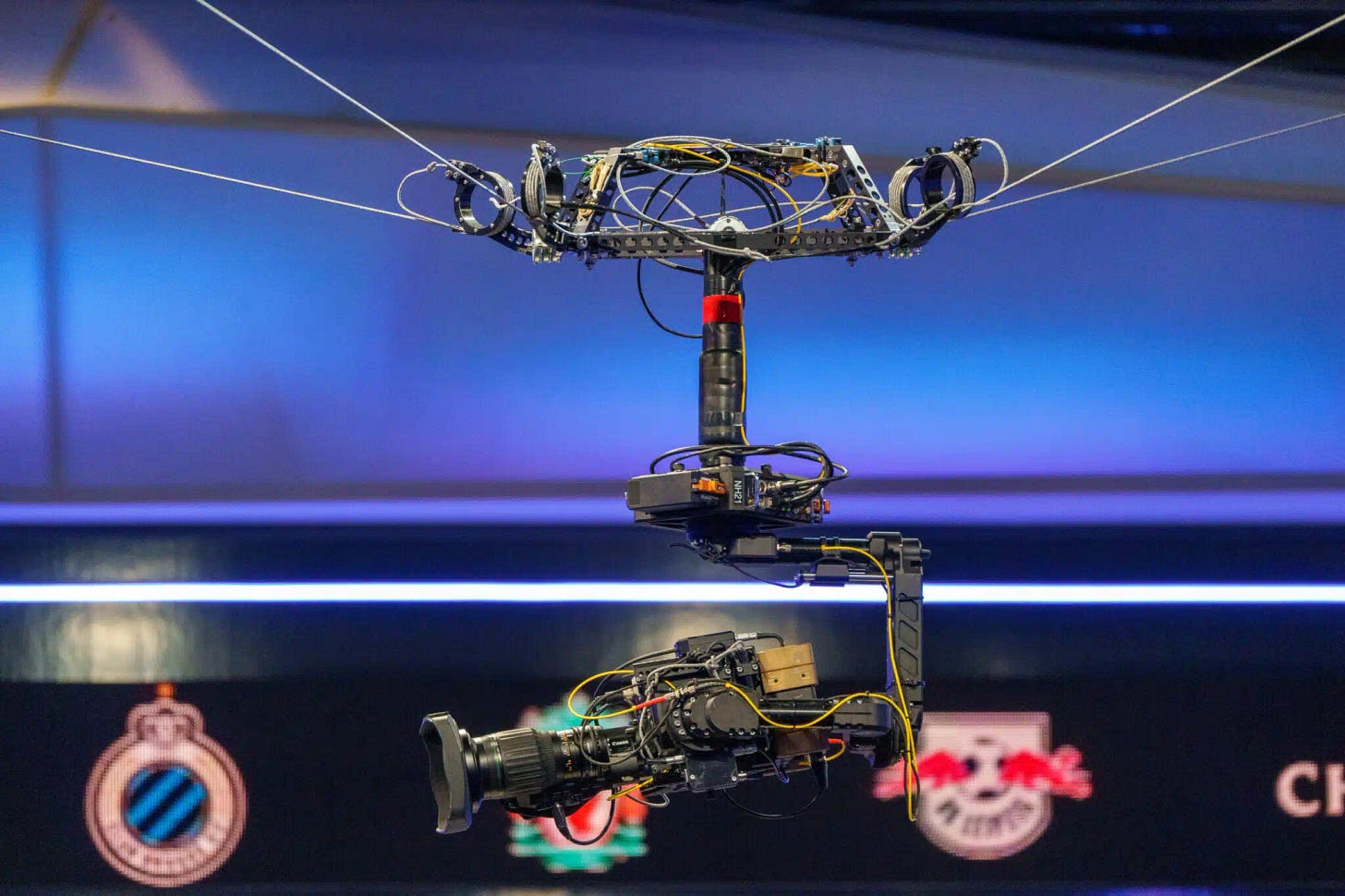The Revolution in Your Living Room: How Tech is Transforming Sports Broadcasting
From 5G to AI: The Cutting-Edge Innovations Bringing the Stadium Experience Home
The First Whistle
The global sports broadcasting technology market was estimated at a staggering $71.57 billion in 2022 and is projected to grow at a compound annual rate of 6.2% through 2030. This figure underscores the immense value and potential of sports broadcasting.
In our last newsletter, we explored how technology is revolutionising the in-stadium experience for sports fans. But what about the millions watching from home? The world of sports broadcasting is undergoing its own seismic shift, driven by cutting-edge technologies that promise to blur the lines between being there and being here.
Today, we'll dive into the complex world of sports broadcasting, examining both the challenges reshaping the industry and the innovative solutions transforming how we experience sports from our living rooms. From fragmentation to innovation, we're witnessing a pivotal moment in sports media history.
Image source: Ross video
2. The Changing Landscape of Sports Broadcasting
Before we explore the innovations enhancing sports broadcasts, it's crucial to understand the challenges and shifts occurring in the industry:
Fragmentation of Viewing Options:
The rise of streaming platforms and decline of cable TV have led to a scattered sports content landscape.
Fans often need multiple subscriptions to follow their favourite teams, leading to frustration and potential viewership decline.
The OTT Revolution:
Over-The-Top (OTT) platforms are reshaping how rights are sold and content is distributed.
Traditional broadcasters are facing stiff competition from tech giants entering the sports streaming market.
Changing Consumption Patterns:
Younger fans are increasingly turning to social media for sports content, preferring highlights and short-form videos over full-length games.
This shift is forcing broadcasters to rethink their content strategies and distribution methods.
Rights Complexities:
The soaring cost of sports rights is putting pressure on broadcasters to innovate and find new revenue streams.
Regional blackouts and international licensing agreements often lead to accessibility issues for fans.
Accessibility Challenges:
The fragmentation of content across multiple platforms creates accessibility issues for fans, especially those with limited financial resources or technological know-how.
Fans in rural areas or regions with poor internet infrastructure may struggle to access streaming services, widening the digital divide in sports consumption.
The complexity of navigating multiple services and platforms can be particularly challenging for older fans or those who aren’t tech savvy, potentially alienating loyal viewers.
These challenges are driving a wave of technological innovation as broadcasters seek to enhance the viewing experience, reach new audiences, and justify the high costs of sports rights. In the following sections, we'll explore how cutting-edge technologies are addressing these issues and revolutionising sports broadcasting.
3. The 5G Game-Changer
As we grapple with the challenges of a fragmented sports media landscape, 5G technology emerges as a potential game-changer for sports broadcasting. This next-generation cellular network promises to revolutionise how we consume sports content:
Ultra-Low Latency: 5G dramatically reduces delay in live broadcasts, bringing viewers closer to real-time action than ever before.
Enhanced Bandwidth: The increased data capacity allows for higher quality streams, enabling widespread adoption of 4K and even 8K broadcasts.
Mobile Viewing Revolution: 5G's speed and reliability make high-quality mobile streaming a reality, catering to on-the-go viewers.
Multi-Angle Viewing: The technology supports simultaneous streams from multiple camera angles, allowing viewers to customise their perspective.
AR and VR Integration: 5G's capabilities pave the way for more immersive augmented and virtual reality experiences in sports broadcasting.
As 5G networks continue to expand, we can expect these innovations to address some of the fragmentation and accessibility issues plaguing current sports broadcasting models, offering fans more flexible and immersive viewing options.
4. Virtual Reality (VR) and 360-Degree Viewing
While Augmented Reality overlays digital elements onto the live broadcast, Virtual Reality takes sports viewing to the next level by placing the viewer directly inside the action. 360-degree camera technology allows fans to experience sporting events as if they were physically present in the stadium.
Current VR Sports Broadcasting:
Live 360-degree streams of games, allowing viewers to pan and zoom the camera view.
Dedicated VR broadcasts that provide a more immersive, first-person perspective.
Partnerships between leagues/teams and VR platforms like Oculus and PlayStation VR.
Benefits of VR Sports Viewing:
Heightened sense of presence, making fans feel like they are courtside or in the stands.
Ability to choose preferred camera angles and viewpoints.
Enhanced engagement through interactive features like replays and stats overlays.
Challenges and Limitations:
Limited adoption due to the high cost and complexity of VR hardware.
Potential for motion sickness with prolonged use.
Difficulty replicating the full sensory experience of attending a live event.
Future of VR in Sports:
Advancements in wireless VR technology and lower-cost headsets.
Integration of AR and mixed reality elements to blend virtual and physical worlds.
Expansion of VR broadcasts to include more sports and leagues.
One example of this technology playing out is F1 Kids, which provides a dedicated 3D augmented graphics feed with child-friendly commentary and animations to enhance the viewing experience to a whole new demographic. As VR continues to evolve, these types of specialised broadcasts could become more commonplace, further blurring the lines between virtual and traditional sports viewing.
With VR and 360-degree viewing enabling a more immersive fan experience, the next frontier is leveraging AI-powered analytics and commentary to deliver even deeper insights and engagement.
Image source: Ross video
5. AI-Powered Analytics and Commentary
As sports broadcasting continues to evolve, AI is playing an increasingly crucial role in enhancing the viewer experience. Through real-time data analysis and automated commentary generation, AI is transforming how fans consume and engage with live sporting events.
Current AI Applications in Sports Broadcasting:
Advanced, AI-driven statistics and graphics: Providing deeper insights into player performance, strategy, and game dynamics.
Automated highlight generation: AI algorithms identify and curate the most exciting moments of a game for instant replays.
AI-generated commentary: Using natural language processing, AI can provide automated, personalised commentary to supplement or replace human broadcasters.
Potential Future Developments:
Personalised AI announcers: Viewers could choose from a range of virtual commentators tailored to their preferences.
Predictive analytics: AI could forecast game outcomes, player injuries, and other key events to enhance the viewing experience.
Multimodal integration: Combining AI-powered analytics with other emerging technologies like AR and VR.
One recent example is the introduction of "AI Michaels," a virtual likeness of the veteran broadcaster Al Michaels, crafted with his permission and trained to sound just like the iconic commentator. This AI-powered announcer made its debut during the recently concluded Paris Olympics, showcasing the potential for AI to enhance and even personalise the sports broadcasting experience.
As AI continues to advance, its integration into sports broadcasting promises to deliver a more engaging, informative, and customised viewing experience for fans.
6. 8K and Beyond: The Future of Resolution
As sports broadcasting technology continues to evolve, the quest for higher resolutions and more life-like video quality has been a key focus. While 4K broadcasts have become increasingly common, the industry is now shifting its attention to the next frontier: 8K.
The Benefits of 8K Resolution:
Sharper, more detailed images with four times the pixel count of 4K.
Improved color depth and contrast, creating a more immersive viewing experience.
Greater clarity for fast-paced sports, reducing motion blur and artifacts.
Challenges and Limitations:
Significant infrastructure upgrades required for 8K production and distribution.
Limited availability of 8K-capable displays and devices in consumer homes.
Bandwidth constraints, especially for live broadcasts, necessitating advanced compression technologies.
The Future Beyond 8K:
Continued advancements in display resolutions, potentially reaching 16K or higher.
Incorporation of high dynamic range (HDR) and wider color gamuts for more vibrant visuals.
Hybrid approaches blending higher resolutions with AI-powered upscaling for broader accessibility.
As the sports broadcasting industry continues to push the boundaries of video quality, fans can anticipate an even more immersive and visually stunning viewing experience in the years to come.
7. Personalised Viewing Experiences
As sports broadcasting becomes more technologically advanced, the ability to personalise the viewing experience for individual fans has become a key focus. By leveraging AI, big data, and advanced analytics, broadcasters are now able to deliver a tailored experience that caters to each viewer's unique preferences and interests.
Current Personalisation Features:
Customisable overlays and information displays: Fans can choose which stats, graphics, and data visualisations are shown on screen.
Personalised camera angles and viewpoints: Viewers can select their preferred camera angles or even switch between multiple perspectives.
Tailored commentary and analysis: AI-generated commentary can be adjusted to match the viewer's preferred style, language, or level of expertise.
Personalised highlights and replays: Algorithms curate highlight reels and replays based on the viewer's favourite players, teams, or game moments.
Future Possibilities:
Predictive recommendations: AI could suggest personalised content, match predictions, or fantasy league insights based on the viewer's habits and preferences (think Netflix).
Integrated social experiences: Fans could engage with like-minded communities, chat with friends, or participate in interactive polls during the broadcast.
Augmented reality enhancements: Personalised AR overlays could provide a truly immersive and customised viewing experience.
As sports broadcasting continues to evolve, the ability to deliver personalised experiences will be a key differentiator, ensuring that each fan feels truly engaged and connected to the action on the field.
8. The Rise of OTT and Streaming Platforms
The traditional cable and satellite television model has long dominated the sports broadcasting industry. However, the rise of over-the-top (OTT) and streaming platforms has started to disrupt this landscape, offering new opportunities and challenges for both broadcasters and viewers.
Advantages of Streaming Sports:
Increased accessibility and convenience for viewers, who can watch on a variety of devices.
Personalised viewing experiences through AI-powered recommendations and customisation options.
Enhanced interactivity, allowing fans to engage with content, statistics, and social features in real-time.
Potential for more niche and specialised sports coverage beyond the mainstream offerings.
Challenges for Broadcasters:
Navigating the fragmented streaming ecosystem and securing distribution deals with multiple platforms.
Adapting to changing viewer habits and expectations around content consumption and monetisation.
Balancing the need for live sports coverage with the growing demand for on-demand and personalised content.
As streaming continues to gain momentum, the future of sports broadcasting will likely involve a hybrid model, where traditional broadcasters and emerging streaming platforms work together to deliver the most engaging and accessible viewing experiences for fans.
9. The Environmental Impact
Worth noting: As sports broadcasting continues to evolve, with the adoption of high-resolution video, advanced graphics, and data-intensive technologies, the environmental impact of these innovations has become an increasing concern. The energy consumption and carbon footprint associated with sports broadcasting operations are under heightened scrutiny.
To address this challenge, industry initiatives like the BAFTA Albert Sport Consortium have been formed to help broadcasters identify and reduce their carbon emissions. Aligning with the broader goals of the UN Sports for Climate Action Framework, the consortium brings together organisations like IMG, Sky Sports, BT Sport, the BBC, ITV, and Channel 4 to collaborate on sustainable sports broadcasting practices.
Formula One, the All England Lawn Tennis Club, and Premier League Productions have also joined the consortium, underscoring the industry's commitment to balancing technological advancement with environmental responsibility. As more broadcasters and sports leagues sign on, the consortium aims to establish best practices and drive the industry toward a more sustainable future.
10. Looking Ahead: The Future of Sports Broadcasting
As we've explored, the sports broadcasting industry is undergoing a remarkable transformation, driven by the rapid advancements in technology. From 5G and AR to VR, AI, and ultra-high-definition video, the viewing experience is poised to become increasingly immersive, personalised, and data-rich.
In the years to come, we can expect to see even more innovative approaches to sports broadcasting. Emerging technologies like holographic displays, haptic feedback, and brain-computer interfaces could further blur the lines between virtual and physical experiences. Artificial intelligence is likely to play an even more prominent role, powering personalised commentary, real-time analytics, and predictive insights.
At the same time, the industry will need to grapple with the environmental impact of these technological advancements, working to reduce energy consumption and carbon emissions through sustainable practices. Collaboration and innovation will be key to ensuring that the future of sports broadcasting is both captivating and responsible.
We hope you've enjoyed this deep dive into the technology transforming the world of sports broadcasting. To stay up-to-date on the latest innovations, be sure to follow us on social media and share this newsletter with your friends and fellow sports tech enthusiasts. We can't wait to see what the future holds!






